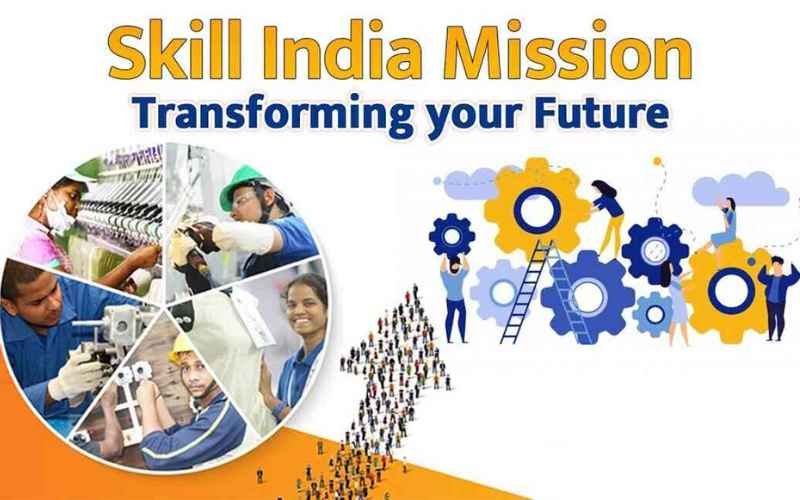Skill India is a program started by the government in 2015 to train over 400 million Indians for different jobs. The goal is to have a strong and skilled workforce by 2022 through various training programs. The program aims to develop skills that match what industries need. You can easily register online to join Skill India as either a trainer or a learner.

The Skill India Scheme is a smart initiative that works toward the development of the country. Here’s all you need to know about this mission.
What are the components of Skill India’s PMKVY?
The Pradhan Mantri Kaushal Vikas Yojana (PMKVY) is a key part of Skill India’s efforts for skill development. It aims to help young people get training for better job opportunities. Here are the main components:
- Short-term training: This provides training to those who didn’t finish school or college, as well as to unemployed individuals. It covers skills based on national standards and also includes soft skills, digital literacy, and entrepreneurship.
- Kaushal and Rozgar Mela: These events encourage community involvement to ensure transparency and accountability in the program.
- Recognition of prior learning: People with experience can get certified and receive additional training to fill any knowledge gaps they may have.
- Special projects: Some training programs may not fit the standard framework, so this part of the scheme accommodates them.
- Monitoring guidelines: The program keeps a close eye on training centers to make sure they maintain quality standards.
- Placement guidelines: The scheme ensures that trained individuals are placed in suitable jobs according to market demands, following strict placement rules.
Why is the Skill India Mission necessary?
Addressing the Skill Gap
The Skill India Mission is crucial because it tackles the disparity between the demand for skilled workers and the existing workforce. Many industries face challenges in finding workers with the right skills, leading to unfilled job positions and hindering productivity. By bridging this gap, Skill India ensures that industries have access to a competent workforce, driving economic growth.
Empowering Individuals
Through training and skill enhancement, the Skill India Mission empowers individuals to secure better employment opportunities. By acquiring relevant skills, individuals become more competitive in the job market, increasing their chances of finding stable and rewarding employment. This empowerment not only improves the livelihoods of individuals but also contributes to overall societal development.
Meeting Industry Needs
Industries are constantly evolving, with new technologies and processes emerging regularly. The Skill India Mission ensures that individuals are equipped with the skills needed to meet these evolving industry demands. By staying aligned with industry requirements, the program enhances the efficiency and effectiveness of the workforce, leading to increased productivity and competitiveness in the global market.
Fostering Economic Growth
A skilled workforce is essential for driving economic growth and development. By investing in skill development, the Skill India Mission lays the foundation for a robust economy. Skilled workers contribute to increased productivity, innovation, and competitiveness, ultimately leading to higher economic output and improved living standards for the population.
In essence, the Skill India Mission plays a pivotal role in addressing the skill gap, empowering individuals, meeting industry needs, and fostering economic growth and development. By ensuring that individuals are equipped with the necessary skills, the program contributes to the overall prosperity and progress of the nation.
What are the objectives of the Skill India programme?
The Skill India programme has several key objectives:
- Training in Market-Relevant Skills: The primary goal is to offer training in skills that are in demand in the job market. By doing so, the program aims to equip over 400 million young people with the skills needed to secure employment by 2022.
- Talent Development Opportunities: The program seeks to create opportunities for talent development within the country. This involves identifying and nurturing individuals’ abilities to excel in various fields, contributing to personal growth and national development.
- Improvement of Underdeveloped Sectors: Skill India aims to enhance the scope and capacity of sectors that are currently underdeveloped. By providing training and support, the program aims to uplift these sectors, leading to their growth and contribution to the economy.
- Collaboration with NSDC: The National Skill Development Corporation (NSDC) plays a crucial role in implementing Skill India’s objectives. By partnering with NSDC, the program leverages its resources and expertise to effectively deliver skill development initiatives across the country.
Overall, the Skill India programme is designed to address the nation’s skill gaps, empower its youth with relevant skills, and drive economic growth by tapping into the potential of every individual and sector.
Courses offered under the Skill India Mission
Under the Skill India Mission, courses are offered across various categories to cater to different skill development needs. Here are the main categories and examples of courses within each:
- Management and Development Programmes: These courses focus on enhancing managerial and administrative skills. Examples include financial statement analysis, modern office practice, and marketing for managers.
- Training of Trainers: These programs aim to train individuals who will in turn train others in specific skills. Examples include accreditation programs for EM trainers and technology infusion courses.
- Entrepreneurship Development Programmes: These courses are designed to foster entrepreneurship skills and encourage business development. Examples include women entrepreneurship development programs, women empowerment initiatives, and schemes like the CRR scheme.
- Skill Development Programmes: These programs offer training in various technical skills required for different industries. Examples include dairy-based Entrepreneurship Skill Development Program (ESDP), carpentry, electroplating, and fashion designing.
- Other Skills: This category encompasses a range of courses aimed at promoting micro-enterprises, cluster development, and providing lending strategies for Micro, Small, and Medium Enterprises (MSMEs).
These courses cover a wide spectrum of skills and sectors, catering to the diverse needs of individuals and industries across the country.
What are the benefits of the Skill India programme?
The Skill India programme offers a multitude of benefits:
- Access to Better-Paying Jobs: Through skill development, young people gain access to higher-paying jobs, improving their standard of living and financial stability.
- Equal Growth Across Sectors: By focusing on grassroots development, the Skill India programme ensures that growth is not limited to specific sectors but spreads evenly across the economy. This balanced growth contributes to overall economic stability and development.
- Enhanced Workforce Efficiency: Trained individuals entering the workforce contribute to increased productivity and efficiency. With the right skills, they can perform tasks more effectively, leading to better results in a shorter time frame.
- Accelerated Economic Growth: A skilled workforce drives economic growth by increasing productivity, innovation, and competitiveness. As more trained individuals enter the workforce, the country’s economic growth potential is enhanced, leading to improved living standards for the population as a whole.
Overall, the Skill India programme not only benefits individuals by providing them with better job opportunities and a higher standard of living but also contributes to the overall development and prosperity of the nation.
What are the schemes for skill development launched by Government of India
The Government of India has launched several schemes for skill development, including:
- Pradhan Mantri Kaushal Vikas Yojana (PMKVY): This flagship scheme aims to provide skill training to over 40 crore youth by 2022.
- Skills Acquisition and Knowledge Awareness for Livelihood Promotion (SANKALP): SANKALP focuses on enhancing employability and entrepreneurship opportunities for youth.
- UDAAN: UDAAN aims to provide skill training to youth from Jammu and Kashmir to increase their employability.
- Standard Training Assessment and Reward Scheme (STAR): STAR focuses on providing monetary rewards to candidates who complete approved training programs.
- Polytechnic Schemes: These schemes focus on providing technical education and skill development through polytechnic institutions.
- Vocationalisation of Education: This initiative aims to integrate vocational education and skill development into mainstream education to enhance employability.
These schemes collectively aim to address the skill gap in India, empower youth with relevant skills, and boost employment opportunities across various sectors of the economy.
Top 20 FAQs about Skill India Mission
- What is the Skill India Mission?
- The Skill India Mission is a government initiative launched to empower millions of Indian youth with employable skills and bridge the gap between demand and supply of skilled labor in various industries.
- When was the Skill India Mission launched?
- The Skill India Mission was launched by the Government of India in July 2015.
- What are the main objectives of the Skill India Mission?
- The main objectives include providing skill training to millions of youth, enhancing employability, promoting entrepreneurship, and fostering economic growth.
- Who is eligible to participate in Skill India programs?
- Skill India programs are open to all Indian citizens, particularly youth, regardless of their educational background.
- What types of skills are offered under Skill India programs?
- Skill India programs offer training in a wide range of sectors including IT, healthcare, construction, manufacturing, tourism, agriculture, and more.
- How can I enroll in Skill India courses?
- You can enroll in Skill India courses through registered training centers or online portals.
- Are Skill India courses free?
- Many Skill India courses are subsidized or offered free of cost to eligible candidates, while some may have nominal fees.
- What is the duration of Skill India courses?
- The duration of Skill India courses varies depending on the skill and level of proficiency being taught, ranging from a few weeks to several months.
- Are there any certification or recognition provided upon completion of Skill India courses?
- Yes, candidates who successfully complete Skill India courses receive certificates or recognition from relevant authorities or training providers.
- How are Skill India programs funded?
- Skill India programs are funded by both the central and state governments, as well as through partnerships with industry, international organizations, and skill development agencies.
- Are there any job placement assistance services provided after completing Skill India courses?
- Yes, many Skill India programs offer job placement assistance, career counseling, and support services to help graduates find employment opportunities.
- Can I start my own business after completing Skill India training?
- Yes, Skill India programs also offer entrepreneurship development training and support to aspiring entrepreneurs.
- What is the role of the National Skill Development Corporation (NSDC) in Skill India programs?
- The NSDC is a key implementing agency of the Skill India Mission, responsible for facilitating skill development initiatives, training programs, and partnerships with industry stakeholders.
- Are Skill India courses available in regional languages?
- Yes, many Skill India courses are available in regional languages to cater to the diverse linguistic preferences of candidates across the country.
- Are there any age restrictions for participating in Skill India programs?
- Generally, Skill India programs are open to individuals of all age groups, although certain programs may have specific age criteria.
- Can I pursue Skill India training alongside my regular education?
- Yes, many Skill India programs offer flexible training schedules that allow candidates to pursue skill development alongside their regular education or employment.
- Are there any special initiatives for women under Skill India?
- Yes, Skill India offers special initiatives and schemes targeted towards empowering women with skills for employment and entrepreneurship.
- What is the role of industry partners in Skill India programs?
- Industry partners play a crucial role in shaping Skill India programs by providing input on skill requirements, offering infrastructure for training, and participating in job placement activities.
- Are Skill India courses recognized internationally?
- Some Skill India courses may have international recognition or equivalency, particularly in sectors with global standards or certifications.
- How can I stay updated on new Skill India initiatives and programs?
- You can stay updated on new Skill India initiatives by visiting the official Skill India website, following government announcements, and subscribing to newsletters or social media channels of relevant agencies and training providers.


